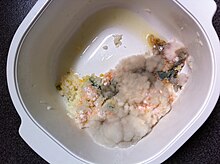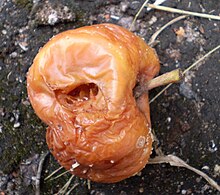
Food spoilage is the process where a food product becomes unsuitable to ingest by the consumer. The cause of such a process is due to many outside factors as a side-effect of the type of product it is, as well as how the product is packaged and stored. Due to food spoilage, one-third of the world's food produced for the consumption of humans is lost every year. Bacteria and various fungi are the cause of spoilage and can create serious consequences for the consumers, but there are preventive measures that can be taken.
Bacteria
Some bacteria are responsible for the spoilage of food. When bacteria breaks down the food, acids and other waste products are generated in the process. While the bacteria itself may or may not be harmful, the waste products may be unpleasant to taste or may even be harmful to one's health. There are many species of pathogenic bacteria that target different categories of food. For example, Clostridium botulinum spoils food such as meat and poultry, and Bacillus cereus, which spoils almost all type of food. When stored or subjected to unruly conditions, the organisms will begin to breed apace, releasing harmful toxins that can cause severe illness, even when cooked safely.
Fungi

Fungi have been seen as a method of food spoilage, causing only an undesirable appearance to food, however, there has been significant evidence of various fungi being a cause of death. Fungi are caused by acidifying, fermenting, discoloring and disintegrating processes and can create fuzz, powder and slimes of many different colors, including black, white, red, brown and green.
Mold is a type of fungus, but the two terms are not reciprocal of each other; they have their own defining features and perform their own tasks. Very well known types of mold are Aspergillus and Penicillium, and, like regular fungi, create a fuzz, powder and slime of various colors.

Yeast is also a type of fungus that grows vegetatively via single cells that either bud or divide by way of fission, allowing for yeast to multiply in liquid environments favoring the dissemination of unicellular microorganisms. Yeast forms mainly in liquid environments and anaerobic conditions, but being single celled, it oftentimes cannot spread on or into solid surfaces where other fungus flourish. Yeast also produces at a slower rate than bacteria, therefore being at a disadvantage in environments where bacteria are. Yeasts can be responsible for the decomposition of food with a high sugar content. The same effect is useful in the production of various types of food and beverages, such as bread, yogurt, cider, and alcoholic beverages.
Signs

Signs of food spoilage may include an appearance different from the food in its fresh form, such as a change in color, a change in texture, an unpleasant odour, or an undesirable taste. The item may become softer than normal. If mold occurs, it is often visible externally on the item.
Consequences
Spoilage bacteria do not normally cause "food poisoning"; typically, the microorganisms that cause foodborne illnesses are odorless and flavourless, and otherwise undetectable outside the lab. Eating deteriorated food could not be considered safe due to mycotoxins or microbial wastes. Some pathogenic bacteria, such as Clostridium perfringens and Bacillus cereus, are capable of causing spoilage.
Issues of food spoilage do not necessarily have to do with the quality of the food, but more so with the safety of consuming said food. However, there are cases where food has been proven to contain toxic ingredients. 200 years ago, Claviceps purpurea, a type of fungus, was linked to human diseases and 100 years ago in Japan, yellow rice was found to contain toxic ingredients.
Prevention
A number of methods of prevention can be used that can either totally prevent, delay, or otherwise reduce food spoilage. A food rotation system uses the first in first out method (FIFO), which ensures that the first item purchased is the first item consumed.
Preservatives can expand the shelf life of food and can lengthen the time long enough for it to be harvested, processed, sold, and kept in the consumer's home for a reasonable length of time. One of the age old techniques for food preservation, to avoid mold and fungus growth, is the process of drying out the food or dehydrating it. While there is a chance of it developing a fungus targeted towards dried food products, the chances are quite low.
Other than drying, other methods include salting, curing, canning, refrigeration, freezing, preservatives, irradiation, and high hydrostatic pressure: Refrigeration can increase the shelf life of certain foods and beverages, though with most items, it does not indefinitely expand it. Freezing can preserve food even longer, though even freezing has limitations. Canning of food can preserve food for a particularly long period of time, whether done at home or commercially. Canned food is vacuum packed in order to keep oxygen, which is needed by bacteria in aerobic spoilage, out of the can. Canning does have limitations, and does not preserve the food indefinitely. Lactic acid fermentation also preserves food and prevents spoilage.
Food like meat, poultry, milk and cream should be kept out of the Danger Zone (between 4 and 60 °C (39 and 140 °F)). Anything between that range is considered dangerous and can cause pathogenic toxins to be emitted, resulting in severe illness in the consumer. Another way to keep food from spoiling is by following a four step system: Clean, Separate, Cook, Chill.
Detection
The detection of spoiled food can be crucial in preventing Foodborne illnesses, and various methods have been developed to detect spoilage. One such method is the use of biosensors, which are devices that use biological components to detect specific substances or changes in the environment. Biosensors can detect spoilage by identifying the byproducts produced by bacteria or fungi during the spoilage process.
Another method of detecting spoilage is through the use of gas sensors. Bacterial contamination of food and drinks can generate unpleasant odours and toxic substances, and e-noses(gas sensor) can perform odour detection continually and are not subject to individual sensitivity.
Lastly, colorimetric analysis can also be used to detect spoilage in food products. Biogenic amines are the important markers for food spoilage, therefore, an on-package sensor for biogenic amine detection is crucial for food quality control. The colorimetric sensors use a chemical reaction between a substance in the food product and a reagent to produce a color change. The color change can indicate the presence of spoilage, as well as the extent of the spoilage.
These methods of detecting spoilage can be used in combination to provide more accurate results, while it is important to note that these methods are still in the research and development phase, and may not be available for commercial use. However, the development of these methods shows promise in improving food safety and reducing food waste.
See also
- Decomposition
- Food preservation
- Food grading
- Foodborne illness
- Shelf life
- Spoilage (wine)
- Meat spoilage
References
- ^ Garcha, S (September 2018). "Control of food spoilage molds using lactobacillus bacteriocins". Journal of Pure and Applied Microbiology. 12 (3): 1365–1373. doi:10.22207/JPAM.12.3.39.
- Tull, Anita (1997), Food and nutrition (3 ed.), Oxford University Press, p. 154, ISBN 978-0-19-832766-0
- Tricket, Jill (2001-07-15). The prevention of food poisoning. Nelson Thornes. p. 8. ISBN 978-0-7487-5893-7.
- ^ "What is Food Spoilage? | FoodSafety.gov". www.foodsafety.gov. 2016-03-08. Retrieved 2019-04-07.
- ^ Pitt, John I.; Hocking, Ailsa D. (2009). Fungi and Food Spoilage. Bibcode:2009ffs..book.....P. doi:10.1007/978-0-387-92207-2. ISBN 978-0-387-92206-5.
- "Fungus Vs. Mold". Sciencing. Retrieved 2019-04-07.
- Tricket, Jill (2001-07-15). The prevention of food poisoning. Nelson Thornes. p. 9. ISBN 978-0-7487-5893-7.
- "Protecting Your Family from Food Spoilage". www.usda.gov. Retrieved 2023-11-08.
- Food spoilage and food pathogens, what's the difference? October 22, 2015, Michelle Jarvie, Michigan State University
- Jeanroy, Amelia; Ward, Karen (2009-07-31). Canning & Preserving for Dummies. Wiley. p. 39. ISBN 9780470555453.
- Magoulas, Argyris (February 22, 2016). "What is Food Spoilage?". Foodsafety.gov. U.S. Department of Health & Human Services. Retrieved October 25, 2018.
- "Keep food safe by implementing the "FIFO" system". MSU Extension. 2014-03-03. Retrieved 2023-11-08.
- US Food and Drug Administration (18 January 2023). FDA Food Code 2022: Full Document. College Park, MD: U.S. Food and Drug Administration. pp. Annex 5-31.
{{cite book}}: CS1 maint: date and year (link) - Jeanroy, Amelia; Ward, Karen (2009-07-31). Canning & Preserving for Dummies. Wiley. p. 41. ISBN 9780470555453.
- Zapaśnik, Agnieszka; Sokołowska, Barbara; Bryła, Marcin (2022-04-28). "Role of Lactic Acid Bacteria in Food Preservation and Safety". Foods. 11 (9): 1283. doi:10.3390/foods11091283. ISSN 2304-8158. PMC 9099756. PMID 35564005.
- Schaertel, B. J.; Firstenberg-Eden, Ruth (1988). "Biosensors in the food industry: present and future". Journal of Food Protection. 51 (10): 811–820. doi:10.4315/0362-028X-51.10.811. PMID 28398862.
- ^ Casalinuovo, Ida A.; Di Pierro, Donato; Coletta, Massimiliano; Di Francesco, Paolo (2006). "Application of electronic noses for disease diagnosis and food spoilage detection". Sensors. 6 (11): 1428–1439. Bibcode:2006Senso...6.1428C. doi:10.3390/s6111428. PMC 3909407.
- Siripongpreda, Tatiya; Siralertmukul, Krisana; Rodthongkum, Nadnudda (2020). "Colorimetric sensor and LDI-MS detection of biogenic amines in food spoilage based on porous PLA and graphene oxide". Food Chemistry. 329: 127165. doi:10.1016/j.foodchem.2020.127165. PMID 32504919. S2CID 219528228.